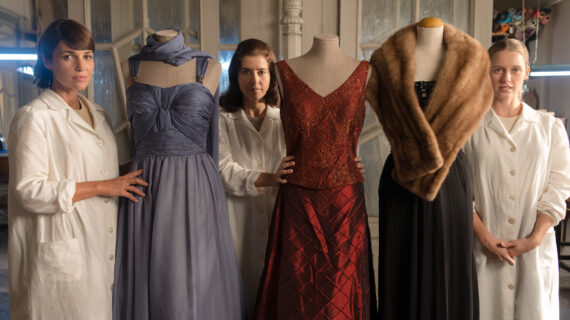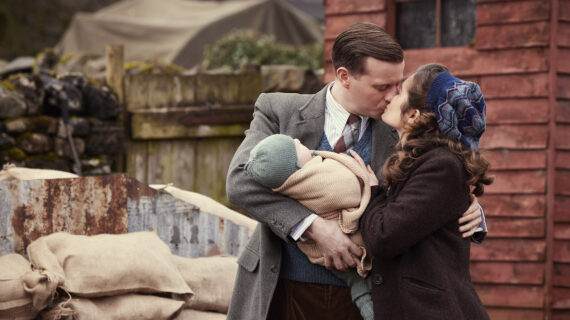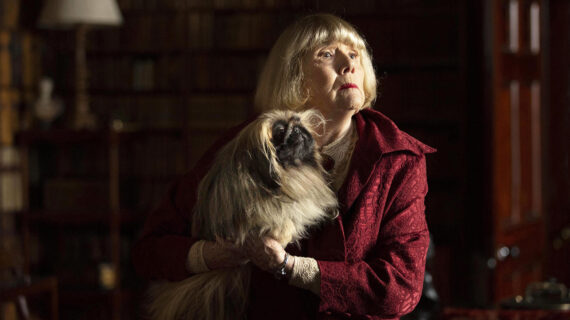[Tom Zinnen, Outreach Specialist, Biotechnology Center, University of Wisconsin-Madison]
Welcome, everyone, to Wednesday Nite @ the Lab. I’m Tom Zinnen. I work here at the U.W.-Madison Biotechnology Center. I also work for U.W.-Extension Cooperative Extension, and on behalf of those folks and our other co-organizers, Wisconsin Public Television, the Wisconsin Alumni Association, and the U.W.-Madison Science Alliance, thanks again for coming to Wednesday Nite @ the Lab. We do this every Wednesday night, 50 times a year.
Tonight, it’s my pleasure to introduce to you three dairy scientists from here at U.W- Madison. The first is Samantha Weaver. She’s from Northfield, Minnesota, and she got her undergraduate degree here at U.W.-Madison, and he’s now a PhD grad student.
The second person is Stephanie Metzger. She’s from Akron, Ohio. She went to Ohio State University to study animal sciences, and she’s here as a PhD student at U.W.-Madison.
And then, Professor Laura Hernandez from the Dairy Science Department. She was born and raised in El Paso, Texas. She went undergrad at New Mexico State University at Los Cruces and got her PhD at the University of Arizona in Tucson. And then she came here to U.W.-Madison.
Tonight, were going to talk about – they’re going to talk about udder anatomy and physiology. We get to have a dissection of an udder. I’ve never seen it before. As a plant person, I’m looking forward to it.
[laughter]
Please join me in welcoming all three researchers to Wednesday Nite @ the Lab.
[applause]
[Laura Hernandez, Assistant Professor, Department of Dairy Science, University of Wisconsin-Madison]
Thank you, Tom, for this opportunity. I figured it would be more fun if we were a little unconventional cause I tend to be somewhat unconventional at times. And we’re not going to use a PowerPoint. Going – we’re going kind of old school today, and I really wanted to include my grad students. They’re both senior grad students in the lab, and they do some different things. And we’re going to kind of start with the intro to why mammals are mammals. That’s the fun part. And I’m going to try to give you the highlights of what I spend an entire semester teaching in the fall here to undergraduates in our program. So, I’m a mammary gland biologist. I’m proud to say that I love studying mammary glands and how they work.
[laughter]
And I’m all right with that after 10 years. [laughs] So, I’ve been here for five years, and we basically, in our lab, study how serotonin regulates mammary gland function as well as milk production. But, as I said, I’m mostly very interested in just the mammary gland as a whole and why mammals are mammals. And many students start of in my class, and they ask, Why is a mammal a mammal? And a mammal is a mammal because they have mammary glands. And a lot of people don’t know that – which is quite interesting. But, basically, at some point in time, many, many, many millions of years ago, there was an evolution of what was going on in terms of species on this planet. And, actually, we started off with the egg-laying animals that laid eggs, and they were secreting fluids potentially into these eggs that would give nutrients to the baby. And at some point, over the course of evolution, the species started to evolve in order to better take care of their young. And that is why, at one point, the mammals kind of broke off.
However, we do have a very interesting creature who belongs to the monotreme family, known as the platypus. And the platypus is somewhere between probably a chicken [laughs] and – or a lizard or an egg-laying animal and an actual mammal. So, they still lay eggs, and they do secrete a milk-like fluid.
[camera shot of a drawing board that has a family tree on it with three branches. At the bottom of the tree is the word – Ancestor – with an arrow pointing at a drawing of a dairy cow. At the end of the first branch are Monotremes (with a drawing of a platypus), in the middle branch are Placental Mammals (with a drawing of a bat, rat, and human torso), and the third branch are Marsupials (with a drawing of a kangaroo)]
However, they just do it along their belly. So, they don’t quite have the nipple situation going on, and they do it along the length of their belly. And they are only found mostly in Australia and New Zealand and those types of places. But they’re kind of the last link to reptiles, so to speak.
Then we have my favorite mammal, or marsupial, would be the – coming from the ancestors. So, we have our ancestor tree here –
[return to a camera shot of the drawing board with the Ancestor family tree]
– and we’ve got marsupials, placental mammals, which we’ll spend quite a bit of time talking about, particularly the dairy cow, and then the monotremes. And so, the monotremes would be your platypus. And so, they’re still laying eggs.
The marsupials are the pouch creatures. And they are about the coolest thing I can think of.
[Laura Hernandez, on-camera]
And if ever in my life I was able to actually study them, I would because they’re very, very unbelievable in what they can do. So, they have their young very, very young in development. Their joeys are born about 28 days into gestation. And they’re about this big. [holds up her hand and indicates about the size of a half dollar] And they’re very red. And so, when they’re born, oddly enough, they’re born with very long arms. And they’re able to crawl out of the uterine cavity, through the vagina, when they’re born, and they go into their pouch. And they attach to a nipple in the pouch, and in this – the marsupial is really cool because she can have a joey that is just barely born and make a very unique milk, and then she can have a joey that’s 250 days old and make a completely different milk in the same mammary system. So, each unit is its own compartment, and it’s able to adjust based on the demands of the young. And that’s largely – Sam – Sam will actually cover some of that when she gets to her part, but that’s largely what we study in our lab. So, when an animal is actually lactating, she’s able to control everything just by the demand of the infant. So, we’ll talk more about that as we go through the presentation.
So, they’re really unique in their capability to do that, and they can make these completely different milks. The mammary glands are really different during those time periods, and – and they’re just a really neat situation to study.
The other thing to note is that, actually, the mammary gland genome is like one of the most conserved kind of genomes out there. Like alpha lactalbumin, which we’ll talk about, is a sugar in milk or drives the sugar production in milk. It’s a protein. It is highly, highly conserved across all the species. So, that’s also very interesting but gets back to the fact that the drive was to have something to support the babies so that they could go off and actually survive.
So, those guys are primarily also in Australia and New Zealand, but there are –
[return to the camera shot of the Ancestor family tree]
– like possums would be similar as well.
And then we have our normal placental mammals. Placental mammals are very, very diverse. You go from something, which Rodentia would be the most common, and theres – they are the most numerous as well. So, rodents are the largest class of mammals. There’s many kinds. There’s lots of them of all different sizes.
Then we have bats. Bats are also mammals, and they fly. But they also produce milk. And so very, very diverse. Then you have things like your aquatic mammals. Seals, whales, they also nurse their young. And what’s really, really cool about mammals is that they can make their milk however they want depending on what environment they live in. So, for instance, a whale. She will nurse her young once and go off and forage for six weeks for food to have food so she can sustain herself. But her milk is so nutrient dense, primarily in fat, it’s between 50% and 60% fat, that the young can survive on that while she’s gone. Whereas, a human, she has quite low-fat percentage, and we’ll look at the comparisons of human and goat and cow and some of the nut milks that are out there, but she’s going to have far less fat because she’s feeding more constantly, as would a rodent.
So, it’s highly variable depending also on their access to water. So, camels, for instance, do not have a lot of access to water, and their milk is going to be more nutrient dense because they want to give just what they need to give in order to support that young for that period of time. And they’re able to do this based on what they’re eating, on the environment they live in, and how – and they can adjust to that depending on the scenario. And it really is just quite an unbelievable phenomenon that a female animal can do that. And that’s what really got me into loving mammary gland biology. [laughs]
So, we have these species. As I said, they’re quite different.
I want to talk a little bit about how the mammary gland develops. So, most tissues, organs in your body when you’re born, they’re pretty much where they need to be. You have what you need, and it’s not going to change other than really kind of growing with your body size as you grow. The mammary gland is really different. So, here we have –
[close-up camera shot of the drawing board with the Ancestor family tree which Laura now flips over to reveal a drawing labelled – Hormones of Lactation at the top. Under the heading the rest of the drawing board is split into two categories, Systemic at the top, and Local at the bottom. Under Systemic are the words – Estrogen, Prolactin, Progesterone, Oxytocin, and Glucocorticoids. Under the Heading – Local – are the words – Serotonin, PTHrP, and Growth Factors]
– what we call our hormones of lactation. And I’m going to talk primarily about the systemic part, so how the mammary gland develops after a female animal is born. And then Sam will take over with part of the udder dissection, and she’ll get into how it’s controlled during lactation and some of those things I was mentioning earlier. And then Steph’s going to come in and talk about how the mammary gland protects itself and what the immune system is and how shes able to – how it’s able to defend itself –
[Laura Hernandez, on-camera]
– particularly with some respect to dairy cows and how they work and how that’s going to go.
So, we have all these different hormones. The female animal is born. She has a –
[camera shot of the Systemic Lactation Hormones on the drawing board]
– mammary gland that is very similar to a male in structure. And, in fact, you can induce males to lactate when they’re older. It’s a hormone cocktail; it works. Also, male babies sometimes can born –
[Laura Hernandez, on-camera]
– be born expressing milk called witch’s milk. Any of you guys heard of that? And that can happen if they have an over-exposure to hormones during the birth as well. So, it really is a hormonal cascade that is occurring that is developing this tissue.
So, what happens is the female is going to go along and she’s going to hit puberty, and up until that point you don’t see much change in the structure of the mammary gland itself. It kind of looks like a picked grape branch, so to speak. So, after you pick all your grapes, that’s pretty much what you have leftover in the tissue. And that’s what a rudimentary-type mammary gland looks like. Once a female starts going through the menstrual cycle or the estrous cycle, depending on what species you’re in, you’ll start to see some growth of this, like, naked looking tree, grape tree, or maybe a new tree that you’ve planted that’s never had leaves before. And so, it starts to grow, and it’s getting bigger. And this duct system that’s structuring itself is going to be fundamental to getting the milk out of the mammary gland. And Sam will focus on the epithelial cell, which it’s connected to, and how that works.
So, it’s building this ductile structure, but it’s not growing quite a lot. Then, as the female enters her menstrual or estrous cycle, as the estrogen and the progesterone are going through their waves of increases and decreases, you’re going to see more and more growing, but it’s very small. So, a female, a human female about 21, 22 years of age, that’s about the maximal kind of naked structure you would have prior to getting pregnant.
So, most of the development of the mammary gland is going to really occur during pregnancy. And what happens is there’s going to be a very large change in the hormone cascade that’s occurring as a result of the pregnancy that is going to change the structure of the tissue so that when the female gives birth, she’s ready to lactate. So, we start with what we call mammogenesis, and during the early first, second trimester of a pregnancy, any kind of pregnancy, they’re just shorter or longer depending on what species you’re in, you’re going to start to see this gradual increase in this ductile structure, and it’s going to keep growing. It’s going to get secondary branches and tertiary branches. And then it’s going to start to kind of sprout or form its ovular structures, which Sam will talk about how they work during lactation.
So, they continue to grow and proliferate, and they’re going to populate that tissue that’s sitting there. And largely that tissue that’s kind of hanging out, that doesn’t have much in it, is usually what we call the fat pad. And during – depending on what species you’re in, you’re going to have more fat or less fat. So, humans have quite a bit of fat. Rodents have some more. Cows do not have very much in their mammary gland. In fact, they’re mostly just the fat pad and a lot of connective tissue, which you’ll see some of that when they start to break it apart. So, the tissue is quite different than a mouse mammary gland or even a human mammary gland.
So, what happens is this continues to grow, and when you get to the last stage of pregnancy, your progesterone is quite high, your estrogen is starting to come down but it’s also high, and you start to see differentiation of the cells. And Sam will show you what the differentiated cell looks like. But a normal mammary epithelial cell that’s not functioning looks like your typical square with a dot in the middle of it. And with your nucleus and your cytoplasm and you can’t really see your organelles very well, but that last trimester those cells start to get bigger. They start to elongate and become more columnar looking, and they start to talk to, like, the connective tissue and the adipocytes, as well as through the blood, and they’re going to be changing and your mitochondria are going to get huge and your golgi is going to get huge because it’s going to have to make a lot of protein. And all of these organelles are going to become quite large. And when you look at them on the microscope, you can drastically see how different they are.
So, at the end, depending on what your species you’re in, you’re in what we call lactogenesis phase one. And at this point you would see some lipid droplets forming inside the cells, and depending – in a cow, about a week before she gives birth, give or take a few days, you’ll start to see some milk actually leaking out. In a human, this would not necessarily happen. And, in fact, unfortunately for humans who think too much, clearly, they don’t have their lactogenesis start until after they give birth. And this actually becomes a problem in the clinic or in the hospital because if they don’t start to milk within that first 24 hours, they’re like, “I’m done. I cannot feed my baby. I’m done.” And so, the 72-hour time point is really important in the human population, but cows will actually start to secrete a little bit before they give birth. So, usually when they give birth [snaps her fingers] – they’re ready to go, which, unfortunately, couldn’t be the opposite because they’re probably not thinking about it so much.
[laughter]
But so, that starts to happen, and at this point, they’re really forming colostrum. And we go through this early phase, once they give birth. They have their colostrum, which is 24 to 48 hours, and then we don’t really start collecting mature milk on farms until at least five days in milk because there’s a lot of changes in the composition that occurs during that time period. And then it gets to a more consistent, mature milk. And this is normal in most species that you would see this. And that colostrum is what’s really important to the baby.
In cows, in particular, where they don’t get any immunoglobulin transfer across the placenta, the colostrum is the only place they’re going to get it. Humans at least get some from the placenta, but cows don’t. And so, this is really important to their health and how we make sure that that milk is what they get and that it’s adequate, that they can start off well in life as well.
So, with that, I’m going to switch to Samantha, and she’s going to talk to you about the systemic portion or the local portion, autocrine – paracrine portion of the mammary gland. And then we’ll break down the epithelial cell as well.
[Samantha Weaver, PhD student, Department of Dairy Science, University of Wisconsin-Madison]
Hello, everyone. [laughs] So, I’m going to do the fun stuff, which is actually touching the udder, and Steph’s going to do the fun stuff too. Laura gets paid to have us do the fun stuff.
[laughter]
So, I am really excited to talk to you guys today because I’m going to talk to you about what I research, which is what is going on at the local level of the mammary gland. So, like Laura mentioned, there are lots of systemic hormones, like estrogen and progesterone, that have a big influence on the tissue growing. But during lactation, the vast majority of those hormones get way suppressed down. And the only hormones that are really ramping up during lactation at a whole-body level are prolactin, which is responsible for keeping the cow milking, or human or anything, and oxytocin. And I’ll explain a little bit more about oxytocin in a minute.
Are there any farmers here? Or former dairy people?
[Laura Hernandez, pointing in the crowd]
Except Marge.
[Samantha Weaver, on camera]
Excellent. So, you guys know that this is not an udder. [laughs]
[laughter]
[pointing to a quarter of an udder on a table at the front of the room] This is only a quarter of one udder. So, Steph and I each have a quarter.
[close-up camera shot of the quarter udder]
I’m just going to orient you real quick because that’ll make it easier. So, this cow was slaughtered yesterday, so this tissue is very fresh. We haven’t had it in formaldehyde or anything. It’s just fresh tissue.
[Samantha Weaver, on-camera]
So, if I flip it over, you’ll see right here is a teat.
[close-up camera shot of Samantha holding the teat]
So, you can orient it this way. [picks up the udder and lets it fall down so that the teat is at the bottom] This is how the udder would actually be sitting on the cow. And it’s easy for me to grab up here at the top of the udder because they’re incredibly thick, strong tissues up here, ligaments, that hold the mammary gland in place, essentially. So, if you think about the way that a cow’s built, short of me getting down on all fours –
[laughter]
– you all know what I mean.
She needs a lot of connective tissue to hold that mammary gland up into her body. And the mammary gland, like I said, this is a pretty small –
[Samantha Weaver, on-camera]
– mammary gland for a cow. They can be just enormous. So, if you think about that proportional to how much weight that cow has to hold up, her ligaments are incredibly strong holding the udder up on her body.
So, Steph’s going to talk to you more about the teat. I’m going to leave the teat alone for now. Could – I’m going to talk to you a little bit about the local factors that regulate what’s going on in the udder. And I’ll do that by sort of talking you through the udder itself.
So, up in here, all this just white tissue –
[close-up camera shot of the side of the udder]
– basically, is called parenchyma. So, parenchyma is essentially the area of the tissue that’s responsible for making the milk.
[Samantha Weaver, on-camera]
Parenchyma has epithelial cells in it. Epithelial cells, mammary epithelial cells, are the milk producing units of the mammary gland.
[camera shot of the drawing board which now has four drawings on it; in the upper left is a cross-section of the cow udder showing the teats at the bottom the milk ducts at the top and the gland cistern in the middle. Additionally, the top of the teat is marked by the streak canal that leads to a sphincter that lets the milk out. On the top right of the drawing board there is an inset drawing of the Lobules at the end of the Milk Ducts which contain Alveoli. To the right of the Lobules inset is another inset drawing of the Alveoli themselves which are lined by Mammary Epithelial Cells. At the bottom of the drawing board is a drawing of a cross-section of a Mammary Epithelial Cell]
So, if you can sort of follow my diagram here – which, sorry, it’s sort of small – you have milk coming out at the teat, like I mentioned. So, the milk –
[close-up camera shot of Samantha holding up the udder with the teat at the bottom]
– is going to be getting ejected down here.
[Samantha Weaver, on-camera]
This is the same system, by the way, in the human. It’s just that the mammary gland goes the other way, but it’s the exact same system.
So, you have your epithelial, or excuse me, your parenchyma tissue, which is all this big conglomeration of tissue up here. [pointing to the white tissue on the side of the udder] And within the epithel – or the parenchyma tissue you have epithelial cells. So, an epithelial cell is the functional unit that actually makes the milk.
[close-up camera shot of the side of the udder]
And I’ll talk through sort of what goes on in an epithelial cell because it’s absolutely amazing.
The epithelial cells are forming a big fat ring. And that ring is an alveoli. So, the other place that you have alveoli in your body, or a cow does, is in your lungs. So, the alveoli need to snap open when a baby is born, for example, to allow you to breathe.
The alveoli in the mammary gland fill up with milk. So, they’re teeny, teeny, tiny. We can only view them on the microscope. There’s no way you could see them with the naked eye. And those are the grapes, like Laura was talking about. The – the grape tree. The grapes are the alveoli. Each one of those alveoli is surrounded by a ring of mammary epithelial cells. Those alveoli empty into exactly what she described, which is a tree. There’s a whole series of ducts that wind their way down to the bottom, or the teat cistern in a cow, and then the milk empties out of the teat.
So, if we look right here –
[close-up camera shot of Samantha holding up a second udder at the table]
– Steph’s going to talk to you a little bit more about the cistern for immunological reasons, but you can see that there it actually looks like Swiss cheese. So, in the teat cistern itself, there are essentially a whole series of holes that just open up, and those are connecting to tubes that then connect to bigger tubes that then connect to other tubes that eventually lead up to the alveoli. And all those tubes –
[Samantha Weaver, on-camera]
– empty down into the teat cistern. There’s actually still milk in this – in this udder. So, if I were to palpate –
[return to the close-up camera shot of the udder]
– it enough, I’m sure we would get out a sufficient amount of milk.
So, the mammary epithelial cell –
[Samantha Weaver, on-camera]
– is pretty amazing because the mammary gland, short of long chain fatty acids, makes everything itself.
So, think of all the things that we think about when we think about milk. There’s fat, there’s calcium, there’s tons of protein, there’s vitamins. All of those pieces are put together in the mammary epithelial cell. So, the mammary gland receives everything in its single unit components. So, protein is made up, for example, of amino acids. Those amino acids travel through the circulation. They arrive at the mammary gland, and only in the mammary epithelial cell is everything put together.
So, the mammary gland has this incredible synthetic capacity in that it’s able to pretty much make everything that it needs to make right at the place that it needs it. And that’s important when you have, for example, I was going to say pups because I work with mice. You can milk a mouse. We have a milk mousing machine.
[laughter]
A mouse milking machine.
[laughter]
Laura built it.
It’s just a little vacuum. You just flip them upside down and vacuum them. We should have brought that. Next year –
[laughter]
– we’ll be back with our mouse milker.
So, it’s really the stimulation at the level of the teat that gets everything put together, that gets everything synthesized and ready to go in the milk. And a pretty fun statistic about that is that in order to produce one unit of milk, so we’ll do a liter, you need 500 liters of blood. So, if you’ve ever seen a dairy cow, she has this whopper – these whopper big veins that run all the way up her body. You all kind of know what I’m talking about. They look like snakes. I mean, they’re just huge, along her underbelly. And that’s because she has enormous demands for blood during lactation in order to provide enough nutrients, amino acids, building blocks to be able to synthesize everything in the gland.
So –
[speaking to Laura]
What else do you want me to talk about?
[audience laughs]
She’s the boss.
Anything else? Steph, why don’t you take over?
[Stephanie Metzger, PhD student, Department of Dairy Science, University of Wisconsin-Madison]
Okay. And I am going to talk a little bit about how we keep dairy cows healthy. Laura is actually my co-adviser.
Oh.
[Laura takes the drawing that is on the drawing board and turns it 90 degrees]
[Laura Hernandez]
There we go.
[Stephanie Metzger, on-camera]
My other adviser is Dr. Pamela Ruegg. She works with mastitis, which is inflammation of the mammary gland, which is something that we definitely don’t want because we want our cows to be as healthy as possible, producing as much milk as possible, that’s the best product we can get out to consumers.
So, the first line of defense, because dairy cows are – they lay down for most of the day. They eat, they lay down, they chew their cud, they let that blood flow and get to the mammary glands so they can produce as much lactose and protein as possible.
So, the first defense is the skin, which is obviously all over the outside of the cow.
[close up camera shot of the drawing that is on the drawing board which is a cross-section of the teat. On the outside of the teat is the skin and then at the bottom of the teat are bacteria which live on the outside of the teat near the sphincter opening of the teat. Within the sphincter of the teat live bacteria and keratin and fatty acids]
So, you can see here that we have the skin –
[close-up camera shot of the second udder on the table with Stephanie holding it up]
– and there’s some hair here.
[Stephanie Metzger, on-camera]
The teats themselves don’t have hair –
[return to the close-up camera shot of the udder]
– on the outside, but the rest of the udder does. And then our next line of defense is – nothing’s going to get in through that skin –
[Stephanie Metzger, on-camera]
– unless we have an injury or something, which doesn’t really happen, so we don’t need to worry about that so much.
But there is a tiny, tiny –
[close-up camera shot of the end of the teat]
– little hole in the very tip of the teat. And this is called our streak canal or teat canal.
[Stephanie Metzger, on-camera]
And there’s a little sphincter muscle there that closes, and it kind of folds in on itself so that nothing can get through there.
And I think you might be able to see it here.
[return to the close-up camera shot of the end of the teat]
There’s kind of a thicker – let’s see – kind of a thicker part here. Right here would be where that sphincter muscle is.
[Stephanie Metzger, on-camera]
But, during milking, that sphincter muscle will be opening so that the milk can actually come out of the teat into the milking machine. So, then there’s another physical barrier in there which is called keratin. And keratin is comprised of proteins and fatty acids that are secreted by the skin cells right in this –
[close-up camera shot of the teat of the udder on the table]
– streak canal. And this will kind of trap bacteria like a net. And then those fatty acids can actually –
[Stephanie Metzger, on-camera]
– kill some of the bacteria. So, our number one way of keeping the udder healthy is by just not allowing bacteria in, in the first place. And they’re pretty good at it. So, that is great.
But what happens if you actually have bacteria that get into the mammary gland? Past these external defenses? This is where we have some cellular defenses. Kind of – it’s kind of the same immune system that you would see in humans. The mammary epithelial cells that Sam talked about that are all up here, they have a lot of cell surface receptors. So, they can find something that’s conserved on a lot of bacteria. For example, bacteria like E. coli that has a molecule called lipopolysaccharide. And that’s really common to a lot of bacteria, whether they’re good bacteria, bad bacteria. So, these mammary epithelial cells will detect that lipopolysaccharide and send out –
[close-up camera shot of the udders on the table]
– some molecules of their own that attract these neutrophils.
And neutrophils have these big, purple nuclei that are lobed so that they can squeeze out of the blood and into the milk more easily. And then they will kill bacteria. They can ingest the bacteria and lice them with reactive oxygen species or perchlorate. So, they actually can produce bleach within the cells on a much smaller scale, obviously, than you would use to – to clean your house.
[laughter]
But that’s essentially what they do on a tiny, tiny molecular level.
So, these neutrophils are going to kill bacteria. And the way that we can tell if a dairy cow has an infection in her udder is prior to milking. Every time a cow is milked, the first thing that the milker will do is fore strip, is what we call it, which is where you basically – you take the teat, and –
[close-up camera shot of Stephanie squeezing the bottom of the teat on the udder]
– you just squeeze it a little bit and you look at the milk that comes out of that. Usually there’s a black surface underneath the cow to make it easier to see. You look and see if the milk looks normal. And if you have any kind of chunks or clots in there, that cow’s milk is not going to go into the bulk tank with all the rest of it. That’s not going to get sold to the public. She’s going to be put in a separate pen, milked at the end, and then that milk will not be sold to anyone.
We can collect milk samples and try to find out which bacteria are actually causing this infection. So, we’ll take a milk sample, we’ll plate it in our lab, we’ll check it 24 hours later, and we can identify these bacteria because we have a few common ones that we look out for. So, we can identify these bacteria, and then, if we have certain bacteria, we might want to administer some intramammary antibiotics.
And I know there’s a lot of talk about antibiotics in milk. Oh, my gosh, antibiotics in milk. Well, they’re only administered in through the mammary gland. And then, once you have administered antibiotics to a cow, you put a red leg band on her. So, that signifies that she cannot be milked with all the rest of the cows. This milk with the antibiotic residues, that will get dumped. If you try to put a cow with antibiotic residues in your bulk tank milk – all those tanks get tested at your milk processor – that milk will get dumped, and the farmer is going to get in big trouble. It costs a lot of money, and there’s a lot of incentive for producers not to put antibiotics in milk. So, every load gets tested. There’s no antibiotic residues in the milk. The antibiotics all have withdrawal periods, and we also watch for the return of the milk to normal appearance. So, that way the milk that doesn’t have residues and is back to a normal appearance – so, this cow’s healthy again, that’s when she can go back in the group with all her – all her buddies and go back into the bulk tank and we can sell that milk again.
[Whispering to herself] What else?
Oh, I also have – changing the subject from the antibiotic residues – you know when you go to the doctor and you have a sore throat and they feel your throat to see if they can feel your tonsils, if they’re swollen? I have a lymph node from the mammary gland here.
[close-up camera shot of the lymph node that Stephanie is holding up]
So, there’s a lot of lymph nodes because we want to activate this immune system and keep all our bacteria out of here. So, this is how big a lymph node would be that’s at the top of the udder. And then when you cut it down the middle –
[the udder has been cut down the middle and Stephanie opens the node along the cut]
– it has a lot of – a lot of fluid flowing through it, and you can kind of see it’s this dark color. And then this is where some immune cells will get activated and the body will say –
[Stephanie Metzger, on-camera]
– “Hey, these are the bacteria we need to kill so let’s educate you on how to kill them.” So, this is kind of the training enter for some of our immune cells.
[Whispering to herself] Ah, lets see.
So, I think that is most of what I wanted to say about the immune system.
[Laura Hernandez, on-camera]
Alright, back to me, I guess.
So, I want to mention a couple things before I get into this. So, we decided as we were putting this together, we’d give you a short overview and then we’d try to discuss some things that are out there in the market. One thing I wanted to mention about lactation in general was, as Sam was saying, we have all these separate individual units and I mentioned how the marsupials were really kind of an extreme, but beautiful example of how the mammary gland can adapt.
But the mammary gland, the more often you milk it or the more often you nurse a baby, the more milk you’re going to produce. And that’s going to always be at the expense of whatever else is going on with the mom. Whether she eats enough or she doesn’t eat enough, she will make that milk. And so, your dietary choices can influence the milk that’s going to be produced, and that will become important in a second when I bring up the humans.
[camera shot of the drawing board which now has a table on it comparing eight components of milk (calories, protein, fat, saturated fat, carbohydrates, calcium, vitamin A, and vitamin B) to five varieties of milk (cow, goat, human, almond, and soy)]
Cows, clearly, especially dairy cows, are on a fairly regimented diet. You will get some variability in milk, say from places like Ireland or New Zealand, where they have grazing systems and they put their cows out on pasture because the biggest component that varies that I alluded to earlier on in milk is fat. And that’s largely due to where you are in your environment, the size of the animal, but largely how often you feed your baby is a big part of that. So, there can be different fat flavors that come up or different fat structures that are in different grasses that can affect the flavor of milk. And that’s going to be the most thing that you would notice.
And also, has anyone ever heard of liquid gold?
No. Colostrum?
[Samantha Weaver, on-camera]
We have.
[Laura Hernandez, on-camera]
Yes. Woo! Colostrum has lots of fat and lots of protein, and it’s largely that color. It has to due with the amount of protein and fat that is in the milk.
So, depending on what kind of fats you – you eat and you’re going to adjust youre – the way the milk may taste. And that’s why, actually, we don’t use a lot of fish oils in our cow diets because that flavor can be conveyed to your product that you will taste.
So, there’s a lot of things you we can manage with milk, you know, to make it more palatable or make it more interesting or flavorful, just on how we feed an animal or how often we milk an animal or many, many different ways we can do that.
The other thing I wanted to note is that the mother is quite exceptional at dealing with this. She changes a lot of things in her body that is all due to signals that are coming from the mammary gland during the lactation.
So, the mammary gland is going to be making all these local factors that Sam talked about, and they’re going to be sending the signals out and they’re going to say, “I need more calcium, so I’m going to take your bone tissue. I don’t care. I’m going to take it.” And, actually, all mammals lose bone during lactation. Every single one of them because there’s not enough that you can eat to compensate. And that’s actually largely what we study, which is why I had to pitch it. But no. We do study a lot of other things too.
And, similarly, if you’re underfed, you’re going to pull your adipose tissue or your muscle tissue to make up for what’s lost. So, the thing to keep in mind, particularly with dairy animals who that is their job, whether they’re goat or sheep or cows, we feed them very well and we feed them to make sure they have enough nutrients to make the milk that they need to make, but also be healthy. And if someone is not doing that, they’re not going to have an animal that is going to be productive. It – it just won’t happen. And so, your really good farmers take really, really, really good care of their animals, and that’s something to really keep in mind because lactation is a very energy taxing time period. And they’re going to be in negative energy balance for some time when they first give birth, anywhere from 30 to 50 days depending on the scenario. And this is a really tricky time period, and we take really good care of our animals. And if you don’t, then they’re not productive. And so, that’s something always to keep in the back of your head when we hear about, How are we really managing these animals? Are they well housed? Are they well cared for? Do they have good water? Are they clean? If they aren’t, they’re not going to be farming for very long. It – it just – it won’t happen because their animals, a) won’t be productive, and it’s not the right way to go about things. So, we do take really good care of them.
So, I wanted to talk about some popular things. These –
[return to the close-up camera shot of the drawing board with the component versus type of milk table]
– milks have some unique properties to them. They have unique proteins. And that’s one of the problems that come up, is that some people are allergic to bovine proteins. That’s – thats a real thing and it really happens and if that happens, then you’re looking for something else to drink. A lot of times, particularly probably quite a few years ago, a lot of people would switch to goat’s milk as an alternative rather than giving cow’s milk to their children if they had some kind of allergy because the proteins are different. They’re goat specific.
The other problem people have with is lactose. And one thing to note about lactose is that –
[Laura Hernandez, on-camera]
– as you increase in age, the enzyme, lactase, that breaks down the lactose, its activity decreases. So, that’s why, as you get older, sometimes you can’t eat 18 pounds of cheese, which I would like to do, because you can’t handle it. But when you’re four, like my daughter, she can probably still do it and be just fine. There are also populations, like the Asian population, who don’t have, sometimes don’t have lactase, or very low levels of lactase and they have much more difficulties breaking down cheese. So, sometimes when people talk about, I’m lactose intolerant, they don’t really know what that means. If you really have a true issue with lactose, it’s because you can’t break it down, and you don’t have the capability in your body. But if you like dairy products, you can go buy lactase at Walgreens or CVS or wherever and eat that right before you eat your dairy product and you’ll be fine. And that’s a true lactose deficiency.
If you’re allergic to the monosaccharide galactose, which is a component of lactose – so, lactose is a galactose plus a glucose. If you have the inability to break that down, then you have a lactose problem as well. But there are all different variations of what this actually is. And a lot of times, in general, people don’t really understand what they’re saying when they say they have a lactose problem. But there are like five different variations of this, whether it’s genetic or it’s just a decrease in the activity of the enzymes to break this down.
So, we have some different kinds of milks here.
[return to the close-up camera shot of the component versus type of milk table on the drawing board]
We have our cow, goat, human, and then two very popular types of milks that are out on the market, almond and soy. And just from what I read three years ago, almond milk has taken over soy. So, that’s like the lead vegetable or nut milk that’s out there. There are a lot of milks. In our class in the fall, we do a milk testing. And there’s hemp milk. There’s camel milk. There’s goat milk. There’s soy milk. There’s organic milk.
[Laura Hernandez, on-camera]
There’s almond milk. There’s lots of milks that are on the shelf that I wonder about sometimes, but there’s lots of them. And we – we end up picking up like 30 different kinds, and we run some tests on them and we try to make the students taste them. Goat you can tell right away, though. You have to have a taste for goat –
[return to the close-up camera shot of the component versus type of milk table on the drawing board]
– milk or goat cheese, if you really are going to consume it because it has its own very special flavor.
So, when we look at this, the other thing to talk about that gets discussed about milk is that it has fat in it or that it’s a really –
[Laura Hernandez, on-camera]
– high fat product. It’s actually not. Whole milk from a cow that you would buy in the store has 3.5% fat in it. 3.5% that’s whole milk. It’s not a very high fat product. It actually has 87% water. Because water is actually – the water content is driven by the amount of lactose that’s in the – the milk. So, the lactose gets made in that golgi apparatus, and it can’t get out. And the only way it can get out is via osmosis. So, it sucks water into the cell, and then the lactose can come out. So that’s why you – that’s what determines the amount of water in your milk is actually the lactose content. And for a complete food, which you’re trying to get back to thinking we’re feeding a baby that is not able to survive on anything, you could survive on this just fine.
[return to the close-up camera shot of the component versus type of milk table on the drawing board]
Its – and now, like they fortify it with some stuff like vitamin D, which we’ll get to in a second.
But this is a hundred – this is a cup of milk, I believe, is what this – what this is based on. So, you have a cup of milk, and a cow’s milk – and this is whole milk. So, whole milk here. This would decrease depending on 2%, 1%, or skim. It has 150 calories. Goat has about half of that. Your human milk has about the same as goat. And it has more water in it. Its lactose or sugar content is actually –
[Laura Hernandez, on-camera]
– 7% instead of 3.5% in a cow – in a cow’s milk. Almond milk has 40, and soy milk has 80.
The thing to really kind of note here, I’m going to come down in a second, but the big thing is the protein and the fat. And that’s where those nut milks really don’t quite have the level of a mammalian milk.
So, the next big thing, as I said, is protein. And you can see here, again, with these gold stars, this is the highest amount. [note: cows milk has the most gold stars] So, protein, this is eight grams of protein per hundred mils of milk. In fat, in a whole fat milk here. When you look at a goat’s milk, it’s only three. And then human, 1.1. And you can see almond has one gram, and soy has more but with seven. But there’s quite less protein in this, though. If you’re looking for a high protein food, I wouldn’t necessarily say that they’re high protein, at least compared to what cow’s milk you would find on the shelf.
We look at fat content, and this is, again, grams per hundred mil. And the thing to note too about cow’s milk is depending on what dairy breed you’re going with – the fat is going to be variable. So, our Holsteins run 3.5% to 4%, typically. You have the – the second most common breed would be the small little Jersey cows that look like little deer. They’re very sassy. We like them, though, because they’re very interesting to study for calcium. But they are very sassy, and they make a much higher fat and protein milk. And, in Wisconsin, when you sell your milk on components, that’s really important. So, we’re the lead cheese state in the United States. This is where cheese comes from. And we are sold – we sell our milk on components. So, if you have more fat, more protein, you can get a higher price. This is not true in all states.
So, other states are only sold on how much milk they make. So, they may be more interested in having a Holstein because she makes substantially more milk volume-wise, but not necessarily on a body weight-wise because Jerseys are actually more efficient. They, on average, make 70 to 80 pounds of milk a day. But they also have less urine, less fecal output, and require less feed. So, they’re more energy efficient. And this is why, actually, I think there’s been an increase in the number of Jersey cows in the United States. Plus, they’re also more heat tolerant. So, you’ll find quite a few out west because they just don’t get so hot, and that’s also an added benefit. But there’s been a lot of talk about looking at this in terms of our footprint on the environment as a dairy industry.
The next thing is clearly we’re going to have saturated fat in these mammalian milks. And saturated fat is not necessarily a bad thing. Everything is a bad thing in too much entity, but that’s because, as mammals, we make cholesterol. That’s unavoidable. And if we didn’t make cholesterol, that would also be a bad thing. The other thing to note about saturated fat and/or cholesterol is that only 25% of the cholesterol in your circulation is really effected by your food. 75% is by what you make in your body, which is why often, if you have a cholesterol issue, you would change your diet, especially if your levels are quite high. You change your diet, you change your exercise, and you’re still high? It’s because it’s a genetic thing. It’s how much you make. And that’s why they put you on medication. So, you can only change so much based on food, and this is not a lot.
And then you can see clearly goat has two, and then there really isn’t going to be any in the other – there’s not much in the human. It’s negligible and it depends on the diet is the other part with the human milk because we’re not feeding them consistently, clearly. We all like what we like, right?
So, carbohydrates, again, there’s about 12 grams per hundred mils of carbohydrates in cow’s milk. And the next highest one would be human, as I said. And so, this is going to be variable, and the sugar is going to be different in these guys, in the – in the nut milks, than they would be in the mammalian milks because the mammalian milks are all going to be lactose. Same thing across all species. And so, except for the marsupials; they have a little bit different thing going on because they’re a little bit different, or they’re cooler, at least in my opinion.
But you can see that there is sugar in here, but those carbohydrates are going to be different in the nut milks than they would be in the mammalian milk.
Then when we get down to calcium, the highest, except for the soy, which is likely due to probably addition of calcium, so this is natural calcium in the mammalian milk. You’re going to have 280 milligrams per hundred mils of milk of calcium. There – the calcium content is the highest mineral content in the milk. Calcium is going to be the biggest thing that’s in there, and that is because, again, when we go back to why mammals are mammals, we’re mammals because we have mammary glands to support our young, to make sure they can go off, and survive. So, the biggest thing that happens in a child or a calf or a puppy or a kitten is bone growth. And they need the calcium and the phosphorus, as structural components for that long bone growth that they’re going to go through during this time period and that soft tissue calcification that has to occur in a lot of situations.
So, almond doesn’t put anything in there. So, you can see there’s nothing in there. And then your vitamins and your minerals are going to be a little bit different. So, fat-soluble vitamin content is going to vary largely on the fat of the diet. So, your vitamin A, vitamin D, vitamin E, vitamin K, particularly A, D, and E are going to be largely dictated by what you’re consuming. And, in fact, cow’s milk does not have a lot of vitamin D in it. And so, that’s why it is fortified in the United States. We have vitamin D supplemented in our milk as a result of that. But that’s going to vary depending on your diet and, in the case of vitamin D, your exposure to sunlight because that’s going to be the primary way you’re going to make vitamin D. So, in humans, vitamin A and D, it’s very questionable how much is going to be in there. So, it depends on what the mother is eating.
Cows you can see vitamin A. This is 400 milligrams per hundred mils of milk. And then, again, soy milk is somewhat supplemented, but the other thing to note about soy milk is that it has compounds in it that have estrogen-like activity. So, they’re very complementary to some of the things estrogen has, so you might get some of these fat soluble vitamins in a different way as a result of it being soy. So, it’s just a part of the component of what’s in the plant. And then almond milk does not have any. So, mostly almond milk has a little bit of protein and a little bit of fat and some sugar in it.
So, these are kind of the differences in what most people are out there. Again, it’s going to be variable depending on what species you’re in, and there’s a lot of choices that come there, but mammalian milk is set up to be a complete food because of its origin. And the origin gets back to making enough milk to provide for your young and a milk that’s going to allow them to grow in an adequate way. Actually, another take-home is – don’t forget whole milk really does not have much – that much fat in it. It’s only 3.5%, and that’s something that we lose kind of sight of that, you know, we have that there and it’s really not that much and it’s probably an amount that is not unhealthy, if you aren’t consuming lots and lots and lots and lots of other saturated fats.
So, we really wanted to talk to you, kind of, as a big picture with all of these things, but the take-home is that the mother dictates. And dairy cows, they’re fed very well, and in the United States, they’re fed a very standard diet, which is called a total mix ration. And there’s a lot of nutritionists out there tweaking and fine tuning every little thing that they do to make sure that those cows are getting the diet that they need depending on where they are. If they’re lactating, if they’re pregnant, if they’re not lactating, if they’re growing, if they’re a calf, and they’re really trying to figure out what works best and doing that based on where we are in the United States and what the feed stuffs are that are available.
So, you guys are really fortunate here. That’s something I noticed when I came here. You have everything here. When I came from Arizona, we trucked everything in, or we tried to get creative and used things like chili pepper remnants. Or, if you’re in Florida, they use citrus pulp or things like that. So, we do try to make use of what the agricultural inputs are in the different parts of the country to make sure that we’re feeding our animals correctly. But these total mix rations have been well studied here. This is one of the best places to be. In fact, I’d say the best place to be if you’re in the dairy science world. At Cornell University, at the University of Florida, we have a lot of really good scientists that are doing really good things to look at this.
So, with that, we thank you. I really want to thank Sam and Steph for coming along to do this. I think it’s more fun if we do it together because it’s – its just more fun that way. And, hopefully, getting away from the PowerPoint didn’t scare you guys too much.
[laughter]
There was some – there was some discern, I feel – I felt like, from Tom when I told him we weren’t going to use PowerPoint. But we wanted you guys to see this and kind of see what’s going on. And we make use of this, and we do this a lot for at schools and other places to educate people on how milk is made and why mammals are mammals because that’s fun and that’s what I like to study.
So, anyway, thank you guys.
[applause]
Search University Place Episodes
Related Stories from PBS Wisconsin's Blog

Donate to sign up. Activate and sign in to Passport. It's that easy to help PBS Wisconsin serve your community through media that educates, inspires, and entertains.
Make your membership gift today
Only for new users: Activate Passport using your code or email address
Already a member?
Look up my account
Need some help? Go to FAQ or visit PBS Passport Help
Need help accessing PBS Wisconsin anywhere?

Online Access | Platform & Device Access | Cable or Satellite Access | Over-The-Air Access
Visit Access Guide
Need help accessing PBS Wisconsin anywhere?

Visit Our
Live TV Access Guide
Online AccessPlatform & Device Access
Cable or Satellite Access
Over-The-Air Access
Visit Access Guide
 Passport
Passport

















Follow Us